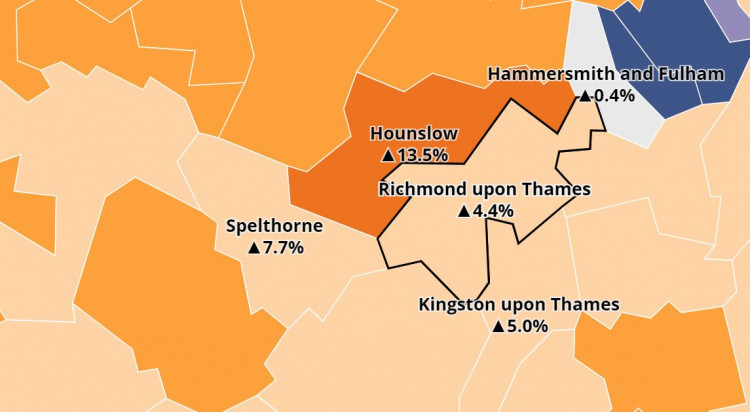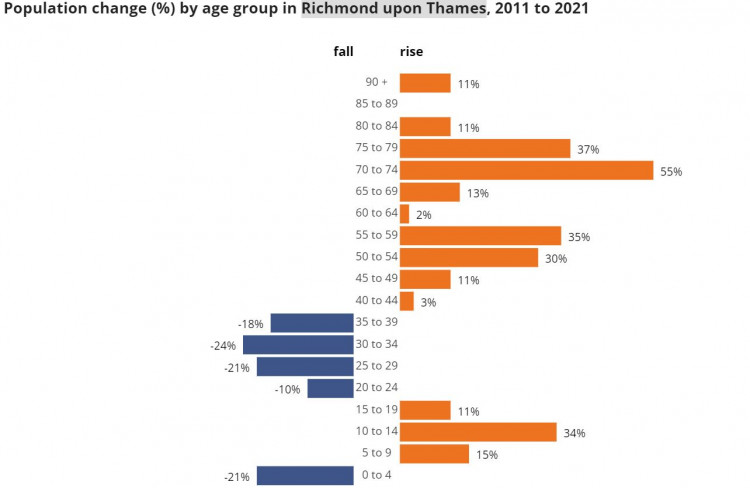Collapse in number of young families in Richmond while pensioner numbers surge – Census
By Rory Poulter 1st Jul 2022
By Rory Poulter 1st Jul 2022

Official data from the 2021 census has revealed a collapse in the number of under 5s and young families in Richmond borough compared to 10 years earlier.
The total number of youngsters aged 0-4 was down by 21% while at the other end of the age scale, the number of those aged 65 and upwards rose by 24.9%.

The shift in the population suggests Richmond is increasingly becoming a refuge for older – and wealthier – people.
The ONS figures are used by the government and local authorities to shape future public services to match the needs of the make-up of the population.
On the face of it, the figures suggest Richmond will need fewer primary school classes in the next 5-10 years, while at the same time the need for social care facilities for the elderly is rising.
The drop in the number of under-5s appears linked to a similarly large fall in the number of young adults – including married couples – who would be starting a family.
On the face of it, there appears to have been an exodus of people aged 20 through to 40, which may be the result of a surge in house prices that has forced many to move out of the borough.

The ONS figures reveal a drop of 10% in those aged 20-24, rising to a fall of 21% in those aged 25-29.
The biggest drop in the population relates to those aged 30-34, who are particularly likely to have young children, where the figure is down by almost a quarter - 24% - in just ten years.
The ONS statistics show a fall of 18 per cent for those aged 35-39.
All the data points to a lack of affordable family homes in Richmond borough - properties that are suitable to raise a family.
House price data published last week, showed the average sale price of detached properties in Richmond were up by almost £300,000 in just one year to £1.76m.
The average terraced property sale price was up by 17% to £909,168, while the figure for flats and maisonettes rose by 12.5% to £520,292.

A number of major housing developments in the borough are going through the planning process, however a great proportion of these include small flats, rather than family homes.
Looking at population increases, the biggest surge has been in those aged 70-74, where the number is up by an astonishing 55%, which is in line with other studies showing Richmond borough is one of the healthiest in the country. The number of those over 90 was up by 10%.
These figures point to something of a demographic timebomb with care homes, social care and hospitals in the area likely to see a large increase in demand.
The ONS figures show the population of England and Wales has increased by more than 3.5 million in the 10 years leading up to Census 2021.
In Richmond upon Thames, the population size has increased by 4.4%, from around 187,000 in 2011 to 195,200 in 2021. This is lower than the overall increase for England (6.6%), where the population grew by nearly 3.5 million to 56,489,800.
Nearby areas like Hounslow and Spelthorne have seen their populations increase by around 13.5% and 7.7%, respectively, while others such as Kingston upon Thames saw an increase of 5.0% and Hammersmith and Fulham saw smaller growth (0.4%).
The largest population increases in London have been seen in Tower Hamlets and Barking and Dagenham, where the populations have grown by 22.1% and 17.7%, respectively.
At the other end of the scale, Kensington and Chelsea has seen a fall of 9.6%.
As of 2021, Richmond is the fifth least densely populated of London's 33 local authority areas, with around 24 people living on each football pitch-sized area of land.
By contrast, Tower Hamlets has become the most densely populated local authority area in England with the equivalent of around 112 people per pitch.
At the other end of the population density scale for England, the amount of land in Eden in Cumbria works out at around five pitches per resident.
CHECK OUT OUR Jobs Section HERE!
twickenham vacancies updated hourly!
Click here to see more: twickenham jobs
Share:












